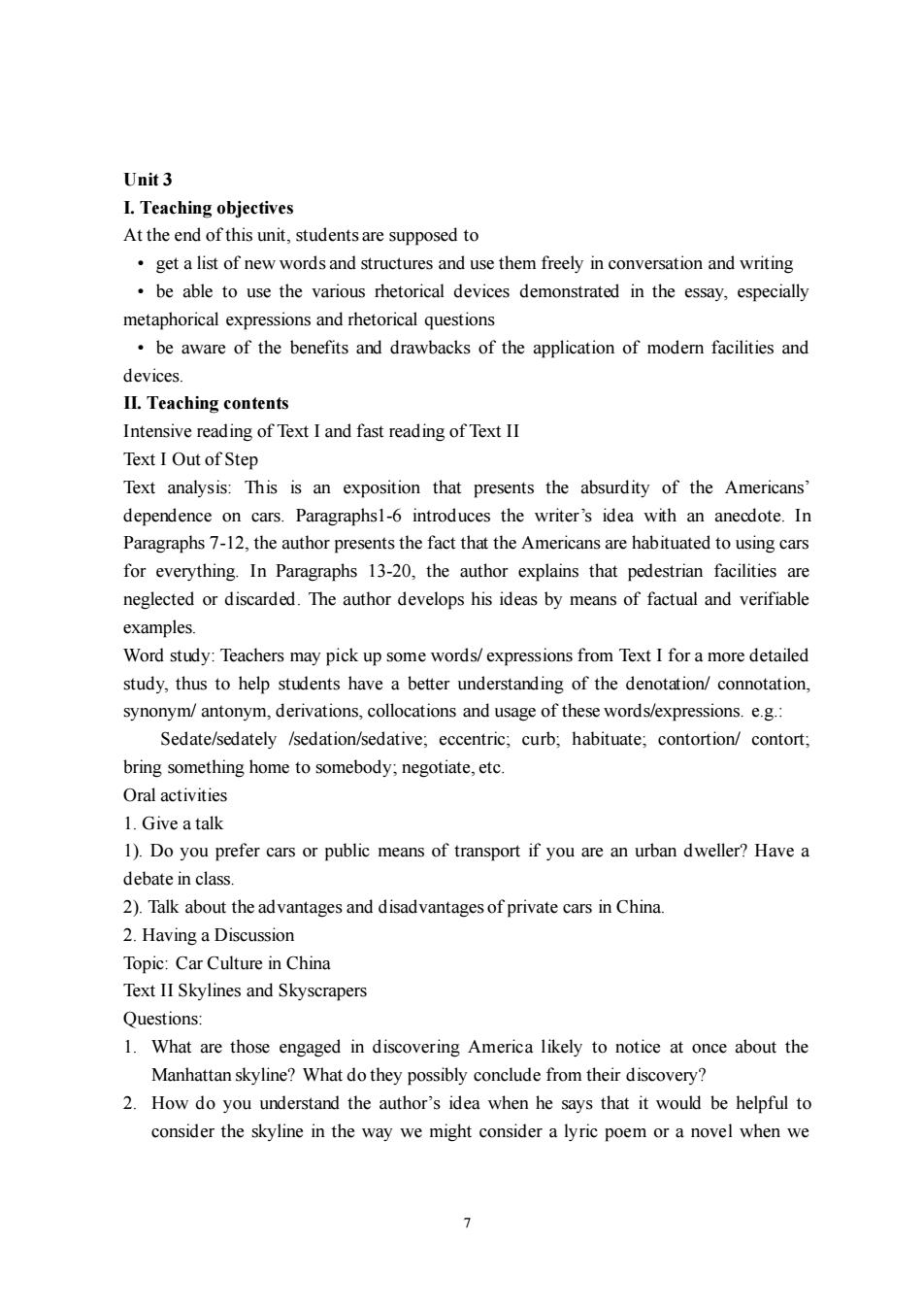正在加载图片...

Unit3 I.Teaching objectives At the end of this unit,studentsare supposed to get a list of new words and structures and use them freely in conversation and writing be able to use the various rhetorical devices demonstrated in the essay,especially metaphorical expressions and rhetorical questions be aware of the benefits and drawbacks of the application of modem facilities and devices. II.Teaching contents Intensive reading of Text I and fast reading of Text II Text I Out of Step Text analysis:This is an exposition that presents the absurdity of the Americans' dependence on cars.introduces the writer's idea with an anecdote.In Paragraphs 7-12,the author presents the fact that the Americans are habituated to using cars for everything.In Paragraphs 13-20,the author explains that pedestrian facilities are neglected or discarded.The author develops his ideas by means of factual and verifiable examples. Word study:Teachers may pick up some words/expressions from Text I for a more detailed study,thus to help students have a better understanding of the denotation/connotation synonym/antonym,derivations,collocations and usage of these words/expressions.e.g.: Sedate/sedately /sedation/sedative::habituate:contortion/contort bring something home to somebody;negotiate,etc. Oral activities 1.Give a talk 1).Do you prefer cars or public means of transport if you are an urban dweller?Have a debate in class 2).Talk about the advantages and disadvantagesof private cars in China 2.Having a Discussion Topic:Car Culture in China Text II Skylines and Skyscrapers Questions: 1.What are those engaged in discovering America likely to notice at once about the Manhattan skyline?What do they possibly conclude from their discovery? 2.How do you understand the author's idea when he says that it would be helpful to consider the skyline in the way we might consider a lyric poem or a novel when we 7 7 Unit 3 I. Teaching objectives At the end of this unit, students are supposed to • get a list of new words and structures and use them freely in conversation and writing • be able to use the various rhetorical devices demonstrated in the essay, especially metaphorical expressions and rhetorical questions • be aware of the benefits and drawbacks of the application of modern facilities and devices. II. Teaching contents Intensive reading of Text I and fast reading of Text II Text I Out of Step Text analysis: This is an exposition that presents the absurdity of the Americans’ dependence on cars. Paragraphs1-6 introduces the writer’s idea with an anecdote. In Paragraphs 7-12, the author presents the fact that the Americans are habituated to using cars for everything. In Paragraphs 13-20, the author explains that pedestrian facilities are neglected or discarded. The author develops his ideas by means of factual and verifiable examples. Word study: Teachers may pick up some words/ expressions from Text I for a more detailed study, thus to help students have a better understanding of the denotation/ connotation, synonym/ antonym, derivations, collocations and usage of these words/expressions. e.g.: Sedate/sedately /sedation/sedative; eccentric; curb; habituate; contortion/ contort; bring something home to somebody; negotiate, etc. Oral activities 1. Give a talk 1). Do you prefer cars or public means of transport if you are an urban dweller? Have a debate in class. 2). Talk about the advantages and disadvantages of private cars in China. 2. Having a Discussion Topic: Car Culture in China Text II Skylines and Skyscrapers Questions: 1. What are those engaged in discovering America likely to notice at once about the Manhattan skyline? What do they possibly conclude from their discovery? 2. How do you understand the author’s idea when he says that it would be helpful to consider the skyline in the way we might consider a lyric poem or a novel when we